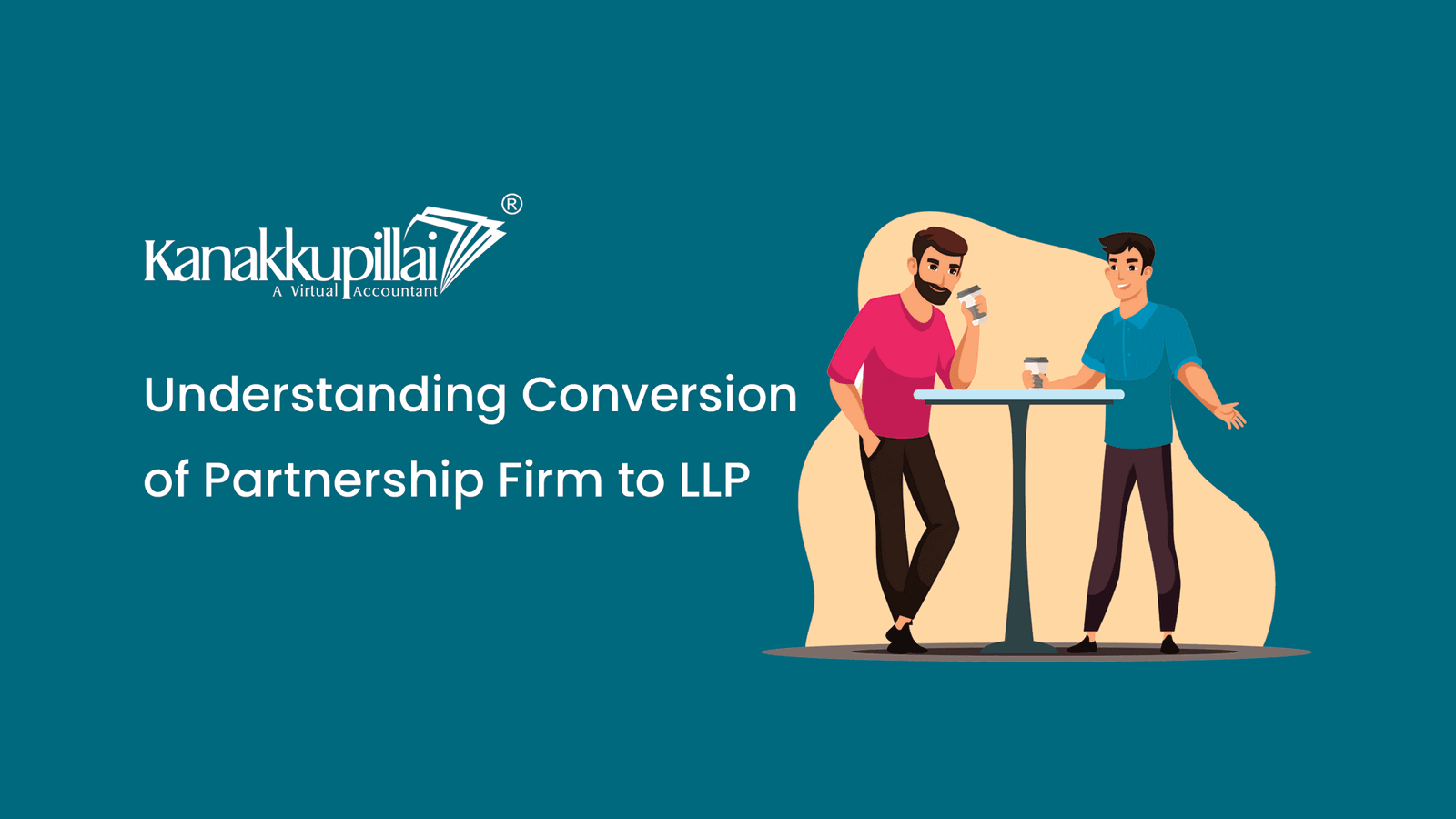![]()
Understanding Conversion of Partnership Firm to LLP
Limited Liability Partnerships (LLPs) has attracted popularity in recent years as an alternative to all the traditional partnership firm legal structure which was opted by many entrepreneurs. This is because of the fact that LLPs provide limitless partners, further flexibility, and many other features. However, the proper reason for the change is that Limited Liability Partnership or LLPs provide a significant benefit in terms of limited liability. LLPs are a mix of both private limited company and partnership firm, the burden on the partner’s personal assets is lowered or lessened. The requirements of small and medium-sized entities are well-served by this form of legal structure of organization.
The Limited Liability Partnership which is LLP legal business structure has more benefits than the conventional partnership. The main features that influence a partnership firm’s decision to become an LLP are perpetual succession, limited liability, and unlimited partners along with many other features.
Key Takeaways
- The proper reason for the change is that Limited Liability Partnership or LLPs provide a significant benefit in terms of limited liability.
- The Limited Liability Partnership which is LLP legal business structure has more benefits than the conventional partnership.
- Step I of the process for converting a business from a partnership to an LLP is name approval and DSC Name approval, Register, then log in to the MCA portal.
- Type FiLLiP (Form for incorporation of LLP)Filling out the application form requires:Information on the RUN – LLP that will be automatically filed.
- Fresh applications must be made for post-conversion.
Differences Between and Limited Liability Partnership and a Partnership
| SN# | BASIS OF DISTINCTION | PARTNERSHIP FIRM | LLP |
| 1 | Number of members | Maximum number of allowed members shall be 20. And in case of banking entity this shall be limited to 10. | No limit displayed on the ceiling of members. |
| 2 | Books of accounts | Not mandatorily required to maintain any books of accounts unless audit under 44AB is required. | Mandatorily required to prepare books of accounts as per provisions pertaining to the LLP Act. |
| 3 | Liability | Unlimited. The partners’ individual assets are also at risk. | Only as far as their capital investment will allow. |
| 4 | Separate legal standing | No it does not have a separate legal standing. | Yes, I do have a separate legal standing. |
| 5 | Digital Signature Certificate or DSC | Not required mandatorily. | Here, every designated partner should have DSC as it is required for the e-filing of the LLP. |
Why should you choose an LLP Instead of a Partnership Firm?
In addition to the main distinctions, the LLP has a few advantages above a typical partnership firm, including the following:
- Flexibility and Freedom of Management: The partners are granted a considerable amount of freedom in how they manage the day-to-day operations of the LLP. The Limited Liability Partnership Act of 2008 does not significantly affect the LLP Agreement, which indicates that the Act has some latitude in how the agreement may be drafted.
- Permanent Succession: In contrast to a regular partnership, an LLP is still in operation after the death of a partner. The LLP is able to conduct business since it is a separate legal entity.Foreign investors and venture capital funds are drawn to LLPs as an investment possibility because they are more structured and organised than regular partnerships and have a corporate framework.
- Multidisciplinary LLPs: An advantage and unique feature of an LLP is the ability for professionals from different disciplines to collaborate.
Conditions for a Partnership Firm to Become an LLP
- According to Section 55 of the Limited Liability Partnership Act of 2008 read with Schedule II of the Act, a partnership firm must be converted to an LLP.
- There cannot be any new partners or for existing partners to stop being partners during the application process because all partners of the firm must be partners of the LLP.
- Before making such an application, it is to be ensured that at least two partners are having both the Designated Partner Identification Number or DPINs and all Partners must possess a currently valid Digital Signature Certificate (DSC).
- The Partnership Act of 1932 requires that the partnership firm which is to be changed or converted be registered.
- The approval is required to be obtained from all partners.
- The partners of the LLP should be those people who were the partners of the partnership firm. Once the conversion is completed or done with, any partner who wants to leave the LLP can take such decision and leave.
- All of Designated Partners shall receive Director Identification Number (DIN) or Designated Partner Identification Number (DPIN).
Step I of the process for converting a business from a partnership to an LLP is name approval and DSC
- Name approval,
- Register, then log in to the MCA portal.
- You must select the option to “RUN – LLP” which is available under the MCA Services menu.
- The full form of RUN basically is Reserve Unique Name.
- The dropdown list’s “Conversion of Firm into LLP” option must be chosen.
- There are thus two names that have been proposed for the LLP.
- Additionally, you can submit any supporting papers in PDF format before clicking the “Submit” button.
- The page is then forwarded to a payment channel where the form’s fee of Rs. 200 must be made.
- After this, the reserved name has a 90-day validity duration.2. Certifications for digital signatures
The Designated Partners of the LLP must have their very own Digital Signature Certificates in order to move past the Name Incorporation stage.
Every e-form needs the Designated Partners’ DSCs attached to the appropriate forms in order to be submitted successfully.
Step II: submitting the paperwork to the RoC
- Form 17 (Application and Statement for conversion of a firm into LLP)
Information required as such must be entered into the application form:
- RUN – LLP form Service Request Number (SRN).
- The name of the LLP as suggested or proposed.
- Details which shall include the firm’s name, address, partnership agreement along with the details of registration.
- Information on the number of partners and the contribution of capital which is to be made.
- Details on secured creditors.
There must be the following attachments:
- Declaration of Firm Partners’ Consent.
- Statement of the firm’s assets and liabilities, certified by a licenced chartered accountant.
- Copy of the acknowledgement for the most recent income tax return.
- a list of all secured creditors, signed by them.
- Anything else that would be a reason2. Type FiLLiP (Form for incorporation of LLP)
Filling out the application form requires:
- Information on the RUN – LLP that will be automatically filed.
- The LLP’s registered address of the office and email address.
- The Registrar’s Office.
- commercial operations’ nature.
- Information about the partners, designated partners, and their DPINs, and DINs as well as PANs.
- Amount of the partners’ contributions to the LLP.
The required attachments are:
- Proof of the registered office of the LLP’s address.
- Subscriber approval.
- Copy of the utility bills and a NOC from the property’s owner (not more than 2 months old).
- approval from any relevant regulatory body, if required.
- LLP/Company information where a designated partner is also a director or partner.
- Proof of the applicants’ both address and identity.
A copy of the Board Resolution or Consent of the existing LLP serving as a No Objection Certificate in cases where the name of the LLP is the same as that of any existing Company or LLP.
The proposed designated partners must electronically sign both forms, and a Cost Accountant, a Company Secretary, or a Chartered Accountant—all of whom must be in full-time practice—must certify their accuracy. The amount of the capital contribution will influence the fee that must be paid.
Step III: Issue of Registration Certificate
The Registrar will issue the LLP’s Certificate of Registration after approving the application.
Step IV: LLP Agreement
30 days after the LLP is incorporated, the LLP Agreement must be presented on Form LLP-3. It must include the following information:
- called the LLP
- Names of the partners who are designated as well as other partners
- Capital contribution and profit-sharing ratios in their various forms
- Regulations for the LLP
- rights and obligations of partners.
Step V: Intimation to the Registrar of Firms.
Within 15 days of the date of incorporation, Form 14 must be submitted to the Registrar of Firms with notification of the conversion into an LLP and any pertinent information about the LLP. The form must be submitted with:
– A copy of the Form FiLLiP
– Submitted incorporation documentation, including the LLP Incorporation Certificate. It may be said that the conversion from a partnership to an LLP is finished in every way once all of these steps have been followed. It should be noted, however, that the previous licences and permits do not transfer to the LLP. Fresh applications must be made for post-conversion.
Paperwork and Applications to Be Filed
Each partner must provide a statement to the Registrar detailing the name, registration number (if applicable), and date the business was registered in accordance with the Indian Partnership Act of 1932 or any other applicable law.
The incorporation document must be filed with the Registrar along with the statement in the prescribed form signed by a chartered accountant, company secretary, cost accountant, attorney, or other person involved in the formation of the LLP attesting that all incorporation requirements have been met.
Registration
After receiving the necessary paperwork, the Registrar will decide whether or not to register the LLP. A certificate of registration will be issued by the Registrar in the event that all documents are verified to be accurate and in accordance with the act’s requirements. The LLP will notify the Registrar of firms with which it is registered in Form 14 less than 15 days after registration. If the Registrar denies registration, the applicant may file an appeal with the tribunal.
Consequences of Registration
- An LLP must be registered under the name that appears on its registration certificate.
- All of the firm’s assets, obligations, rights, and privileges will pass to the LLP.
- If the company was registered under the Indian Partnership Act of 1932, it will stand dissolved and be deleted from all documents kept.
- The LLP may be subject to all legal actions that were pending against the firm.
- Any order or verdict, whether favourable to the firm or unfavourable, may be enforced against the LLP.
- All current agreements and contracts to which the firm was a party shall remain in effect with the LLP as a party.
- Every current appointment made by the company or authority granted to the company must be treated as though it had been given to the LLP.
Responsibility of Partners Before Conversion
All liabilities and obligations of the company accrued before to the conversion will be shared equally by each partner. Any partner who fulfils the obligation will be compensated by the LLP.
Transitional Notice
The LLP must include provisions for a 12-month period that starts no later than 14 days after registration: In every official letter of the LLP, it must be stated that it was converted from a firm to an LLP as of the registration date specified and include the name and registration number (if applicable) of the firm from which it was converted. If the LLP violates the aforementioned clause, it will be subject to a minimum fine of Rs. 10,000 and a maximum fine of Rs. 100,000. If the default is continued, the minimum fine is Rs. 50 per day and the maximum is Rs. 500 per day.
Form LLP No. 17
This document serves as both an application and statement for changing a firm into an LLP. The form is split into two sections: Application in Part A, and statement in Part B.
Part A information requirements:
- if the Reserve Unique Number (RUN) form application SRN has already been submitted. If not, the LLP’s suggested name.
- Name and location of the business.
- Information on the firm’s registration with the Indian Partnership Act of 1932 or with any other law.
- Date of the agreement, which contains information about how the company was founded.
- the firm’s total number of partners.
- The total number of partners in the LLP, which will be calculated based on the information you gave in accordance with the preceding paragraph.
- total investment made by the company in capital.
- specifics of each partner’s agreement.
- Information proving that the only shareholders of the business are all of the LLP’s partners.
- Specifics of the Income Tax Act of 1961-filed income tax return.
- specifics of any ongoing litigation in a court, tribunal, or other body.
- whether the Registrar has ever rejected a conversion application before. If so, the SRN and the justifications for the refusal must be given.
- Details of any orders, judgments, or convictions upheld or overturned by any court, tribunal, or other authority in favour of or against the company.
- Whether any secured creditors exist. If so, whether the conversion was approved with the approval of all secured creditors.
- if the conversion into an LLP requires any authorization or approval. If so, whether the necessary consent was acquired.
Part B: Statement the declaration’s contents
- approval from the partner for the transition from a firm to an LLP.
- The partner must acknowledge that they are jointly and severally liable for all debts incurred prior to the conversion.
- He or she must certify that the LLP Act of 2008 and its rules have been followed and that everyone who is a partner in the company is also a partner in the LLP. That all necessary approvals have been received;
– That all secured creditors have given their consent;
– that to the best of his knowledge and belief, all the information on the form is accurate.
Attachments
- Chartered Accountant in Practice’s Duly Attested Statement of Assets and Liabilities of a Firm
- Statement indicating the company’s partners’ approval.
- a list of all secured creditors, coupled with a statement that they have approved the conversion.
- a copy of the most recent income tax return’s acknowledgement.
- approval from any authority or organisation.
- if any, any optional attachments.
A chosen partner must digitally sign the e-form and include their DIN or DPIN information as well as their PAN number if they do not each have a DIN. A Chartered Accountant, Company Secretary, or Cost Accountant in full-time practise must complete certification. It is necessary to choose an associate or fellow, and to supply a membership number or certificate of practise number. Registrar notification must be made on Form 14.
The following details must be given:
– The name of the company.
– The company’s main office address.
– Information regarding the firm’s registration under the Partnership Act of 1932 or any other law. Additionally, information regarding the LLP into which the firm has been converted must be given. The partner must digitally sign the form and attach a copy of the LLP’s certificate of establishment.
Conclusion
An LLP is a more efficient form of organization than a Partnership Firm. This is accurate only in terms of compliance and taxation. LLP is best for professionals and small business owners. Upgrade your Partnership Firm to an LLP and protect your personal assets while enjoying the benefits of a flexible and efficient business structure.
With Kanakkupillai expert support, the conversion process is quick and seamless. We are the best choice for your LLP Registration in India. Don’t wait – make the switch to an LLP today and secure your success for tomorrow. Contact us now at +91 7305 345 345 for more information and to get started.”





